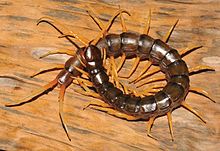
Summary
Scolopendra cataracta is a species of centipede in the family Scolopendridae.[1][2] It is the first known amphibious centipede, growing to up to 20 centimetres (7.9 in) in length.[2][3]
| Scolopendra cataracta | |
|---|---|

| |
| Scientific classification | |
| Domain: | Eukaryota |
| Kingdom: | Animalia |
| Phylum: | Arthropoda |
| Subphylum: | Myriapoda |
| Class: | Chilopoda |
| Order: | Scolopendromorpha |
| Family: | Scolopendridae |
| Genus: | Scolopendra |
| Species: | S. cataracta
|
| Binomial name | |
| Scolopendra cataracta Siriwut, Edgecombe & Panha, 2016
| |
Description edit
Scolopendra cataracta is a giant centipede, growing to around 200 mm (7.9 in) in length; it has long legs and a greenish-black colour.[3] When exposed, it escapes into water. It both runs along stream beds and swims with eel-like horizontal undulations of its body. Out of water, water rolls off the centipede's body leaving it dry as the surface is hydrophobic.[2] The species was discovered, and the first specimen collected, in 2000 near Thailand's Khao Sok National Park.[4][5] Two more specimens were collected near waterfalls in Laos. DNA analysis confirmed they belonged to S. cataracta; the new species was named for the Latin for waterfall.[2] A further specimen was found in the Natural History Museum's collection, in the shape of a misidentified 1928 centipede from Vietnam.[2] The ecological niche is conjectured to be based on going "into the water at night to hunt aquatic or amphibious invertebrates."[3] The species description was published in ZooKeys in 2016.[6]
The species is apparently endemic to Southeast Asia, with specimens from Laos, Thailand, and Vietnam.[2]
References edit
- ^ Bonato L.; et al. (2016). "Scolopendra cataracta Siriwut, Edgecombe, Panha, 2016". ChiloBase 2.0 – A World Catalogue of Centipedes (Chilopoda). Retrieved 27 November 2020.
- ^ a b c d e f Bates, M. (26 June 2016). "'Horrific' First Amphibious Centipede Discovered". National Geographic. Archived from the original on June 26, 2016. Retrieved 1 July 2016.
- ^ a b c Holmes, O. (1 July 2016). "Giant swimming, venomous centipede discovered by accident in world-first". The Guardian. Retrieved 1 July 2016.
- ^ "Dr George Beccaloni – Curator, Orthopteroidea and Wallace Collection". Natural History Museum, London. Retrieved 1 July 2016.
- ^ Nijhuis, Michelle (3 July 2016). "It's always a joy to discover a new species. But there is a downside..." The Guardian. Retrieved 3 July 2016.
- ^ Siriwut, W.; Edgecombe, G. D.; Sutcharit, C.; Tongkerd, P.; Panha, S. (2016). "A taxonomic review of the centipede genus Scolopendra Linnaeus, 1758 (Scolopendromorpha, Scolopendridae) in mainland Southeast Asia, with description of a new species from Laos". ZooKeys (590): 1–124. doi:10.3897/zookeys.590.7950. PMC 4926625. PMID 27408540.


